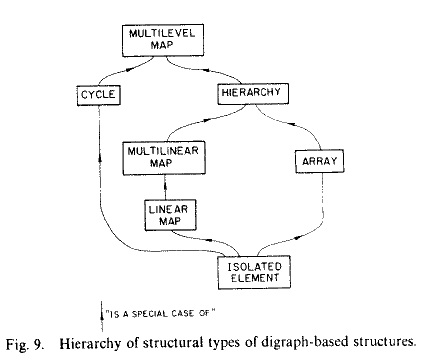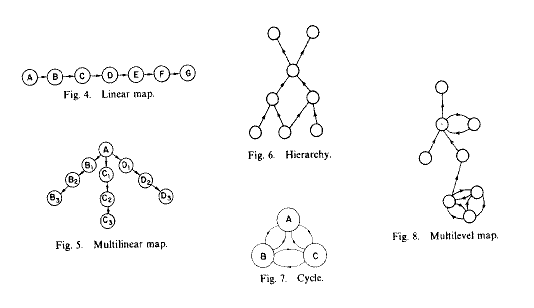

Al Selvin says that "...the degree to which a hypertext database appears
hierarchical is due to its design, rather than a property of the medium
itself."
I am writing, not to take issue with that statement, but rather to suggest
that the discussions about hypertext and matters of that general nature,
having to do with the structure of information, could all benefit if a lot
more people learned a lot more about the fundamentals of structure. And I
would like to suggest how this might be done.
This is not to suggest that I know everything there is to know about
structure--on the contrary, I know enough about it to know how important
it is, and how badly it needs more attention.
But I do want to mention three publications which, if absorbed, would
raise the level of sophistication of discussions about knowledge
structures substantially. While sophistication is not an end in itself,
the question of the structure of knowledge is very fundamental to all
forms of use of knowledge.
Publication #1. John N. Warfield, "Some Principles of Knowledge
Organization", (1979), IEEE Transactions on Systems, Man, and Cybernetics
9(6), 317-325.
This publication portrays the basic structural forms that correspond to
directed graphs, and shows in Figure 9, how these structures are
interrelated. The most elementary structural type shown there is the
"isolated element". The most general structural type shown there is the
"multilevel map", which I have later named the "hybrid structure", because
it incorporates both hierarchical substructures and cyclic substructures.
[Host's Note: Here is Figure 9, as mentioned by John. Also a couple of
other figures from the same paper that may help...]


Using the language given there, one can make a very well-defined statement
such as:
"Hypertext can be modeled after a hierarchy, a cycle, or a hybrid
structure". Whether this statement is true is critical to whether what Al
says is accurate.
Moreover, if the statement is true (I don't know whether it is or not, or
even how to establish it, given the ambiguity of technical language), it
allows all of the structural information given in the reference to be used
in describing hypertext in general and particular instantiations, in
specific cases. Moreover, it would allow attaching numerical descriptors
that would provide structural overviews. For example, on might introduce
a particular hypertext by saying that its "length" is 7, which means that
it has 8 levels; and by saying that it contains 3 cycles, the largest of
which contains 5 members. In a still more sophisticated description, one
could determine the geodetic cycles contained therein, and state their
lengths. Among other things, this would help the aware reader know how
much investment is likely to be required to use the particular hypertext,
and could even be translated into a measure of cognitive difficulty, using
the indexes of complexity that I have developed.
Reference 2. John N. Warfield, "Complementary Relations and Map Reading",
(1980), IEEE Transactions on Systems, Man, and Cybernetics 10(6), 285-291.
This article, drawing on Ref. 1, discusses issues of correctness,
completeness, and skill in reading structures of the type defined in Ref.
1. Among other things, this article provides ideas that can be translated
into such applications as describing large structural packages of
information, minimizing the workload required to do so, recognizing what
is needed to provide completeness as described in the paper, etc.
Reference 3. John N. Warfield (1994), A SCIENCE OF GENERIC DESIGN, Ames,
IA, The Iowa State University Press, Appendix 1 titled "Relations,
Lattices, Structural Types, Structural Metrics". This Appendix integrates
material from Refs 1 and 2, and updates the nomenclature. It also gives
some historical background, showing how what is presented in this Appendix
evolved through the ages. Moreover, it gives fundamental concepts of
model construction that connect technical and psychological issues
involved in model building. It also shows why the commonly used Venn
diagrams are structurally inadequate, in contrast with the digraph-based
forms, and illustrates the use of structural measures to compare
high-level computer languages. Elsewhere in the book, examples of
numerous applications of this material are given, all of which have
relevance to the LO, because they all involve partial resolution of
complexity.
It's true that most people do not study material of this type, and
probably shy away from it for that reason. When compared with
differential and integral calculus, the mathematics involved here are much
easier to learn and potentially of much broader application, especially in
information technology.
The fundamental mathematics, with consistent notation throughout, was
provided in my 1976 book titled SOCIETAL SYSTEMS: PLANNING, POLICY, AND
COMPLEXITY. This book was addressed to systems engineers, but the math
part is basically application-discipline-independent. While this book,
originally published by Wiley, was later reprinted in soft cover, it is
now out of print, but copies can be obtained from the University
Microfilms operation in Ann Arbor, Michigan.
Can I interest anyone in pursuing this line of discussion?
-- John N. Warfield Johnwfield@aol.com